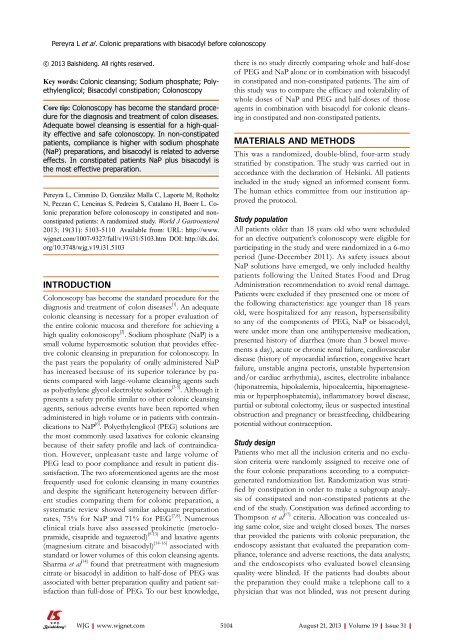PDF (1203k)
PDF (1203k)
PDF (1203k)
Create successful ePaper yourself
Turn your PDF publications into a flip-book with our unique Google optimized e-Paper software.
Pereyra L et al . Colonic preparations with bisacodyl before colonoscopy© 2013 Baishideng. All rights reserved.Key words: Colonic cleansing; Sodium phosphate; Polyethylenglicol;Bisacodyl constipation; ColonoscopyCore tip: Colonoscopy has become the standard procedurefor the diagnosis and treatment of colon diseases.Adequate bowel cleansing is essential for a high-qualityeffective and safe colonoscopy. In non-constipatedpatients, compliance is higher with sodium phosphate(NaP) preparations, and bisacodyl is related to adverseeffects. In constipated patients NaP plus bisacodyl isthe most effective preparation.Pereyra L, Cimmino D, González Malla C, Laporte M, RotholtzN, Peczan C, Lencinas S, Pedreira S, Catalano H, Boerr L. Colonicpreparation before colonoscopy in constipated and nonconstipatedpatients: A randomized study. World J Gastroenterol2013; 19(31): 5103-5110 Available from: URL: http://www.wjgnet.com/1007-9327/full/v19/i31/5103.htm DOI: http://dx.doi.org/10.3748/wjg.v19.i31.5103INTRODUCTIONColonoscopy has become the standard procedure for thediagnosis and treatment of colon diseases [1] . An adequatecolonic cleansing is necessary for a proper evaluation ofthe entire colonic mucosa and therefore for achieving ahigh quality colonoscopy [2] . Sodium phosphate (NaP) is asmall volume hyperosmotic solution that provides effectivecolonic cleansing in preparation for colonoscopy. Inthe past years the popularity of orally administered NaPhas increased because of its superior tolerance by patientscompared with large-volume cleansing agents suchas polyethylene glycol electrolyte solutions [3-5] . Although itpresents a safety profile similar to other colonic cleansingagents, serious adverse events have been reported whenadministered in high volume or in patients with contraindicationsto NaP [6] . Polyethylenglicol (PEG) solutions arethe most commonly used laxatives for colonic cleansingbecause of their safety profile and lack of contraindication.However, unpleasant taste and large volume ofPEG lead to poor compliance and result in patient dissatisfaction.The two aforementioned agents are the mostfrequently used for colonic cleansing in many countriesand despite the significant heterogeneity between differentstudies comparing them for colonic preparation, asystematic review showed similar adequate preparationrates, 75% for NaP and 71% for PEG [7,8] . Numerousclinical trials have also assessed prokinetic (metoclopramide,cisapride and tegazerod) [9-13] and laxative agents(magnesium citrate and bisacodyl) [14-16] associated withstandard or lower volumes of this colon cleansing agents.Sharma et al [14] found that pretreatment with magnesiumcitrate or bisacodyl in addition to half-dose of PEG wasassociated with better preparation quality and patient satisfactionthan full-dose of PEG. To our best knowledge,there is no study directly comparing whole and half-doseof PEG and NaP alone or in combination with bisacodylin constipated and non-constipated patients. The aim ofthis study was to compare the efficacy and tolerability ofwhole doses of NaP and PEG and half-doses of thoseagents in combination with bisacodyl for colonic cleansingin constipated and non-constipated patients.MATERIALS AND METHODSThis was a randomized, double-blind, four-arm studystratified by constipation. The study was carried out inaccordance with the declaration of Helsinki. All patientsincluded in the study signed an informed consent form.The human ethics committee from our institution approvedthe protocol.Study populationAll patients older than 18 years old who were scheduledfor an elective outpatient’s colonoscopy were eligible forparticipating in the study and were randomized in a 6-moperiod (June-December 2011). As safety issues aboutNaP solutions have emerged, we only included healthypatients following the United States Food and DrugAdministration recommendation to avoid renal damage.Patients were excluded if they presented one or more ofthe following characteristics: age younger than 18 yearsold, were hospitalized for any reason, hypersensibilityto any of the components of PEG, NaP or bisacodyl,were under more than one antihypertensive medication,presented history of diarrhea (more than 3 bowel movementsa day), acute or chronic renal failure, cardiovasculardisease (history of myocardial infarction, congestive heartfailure, unstable angina pectoris, unstable hypertensionand/or cardiac arrhythmia), ascites, electrolite inbalance(hiponatremia, hipokalemia, hipocalcemia, hipomagnesemiaor hyperphosphatemia), inflammatory bowel disease,partial or subtotal colectomy, ileus or suspected intestinalobstruction and pregnancy or breastfeeding, childbearingpotential without contraception.Study designPatients who met all the inclusion criteria and no exclusioncriteria were randomly assigned to receive one ofthe four colonic preparations according to a computergeneratedrandomization list. Randomization was stratifiedby constipation in order to make a subgroup analysisof constipated and non-constipated patients at theend of the study. Constipation was defined according toThompson et al [17] criteria. Allocation was concealed usingsame color, size and weight closed boxes. The nursesthat provided the patients with colonic preparation, theendoscopy assistant that evaluated the preparation compliance,tolerance and adverse reactions, the data analysts;and the endoscopists who evaluated bowel cleansingquality were blinded. If the patients had doubts aboutthe preparation they could make a telephone call to aphysician that was not blinded, was not present duringWJG|www.wjgnet.com5104 August 21, 2013|Volume 19|Issue 31|
















